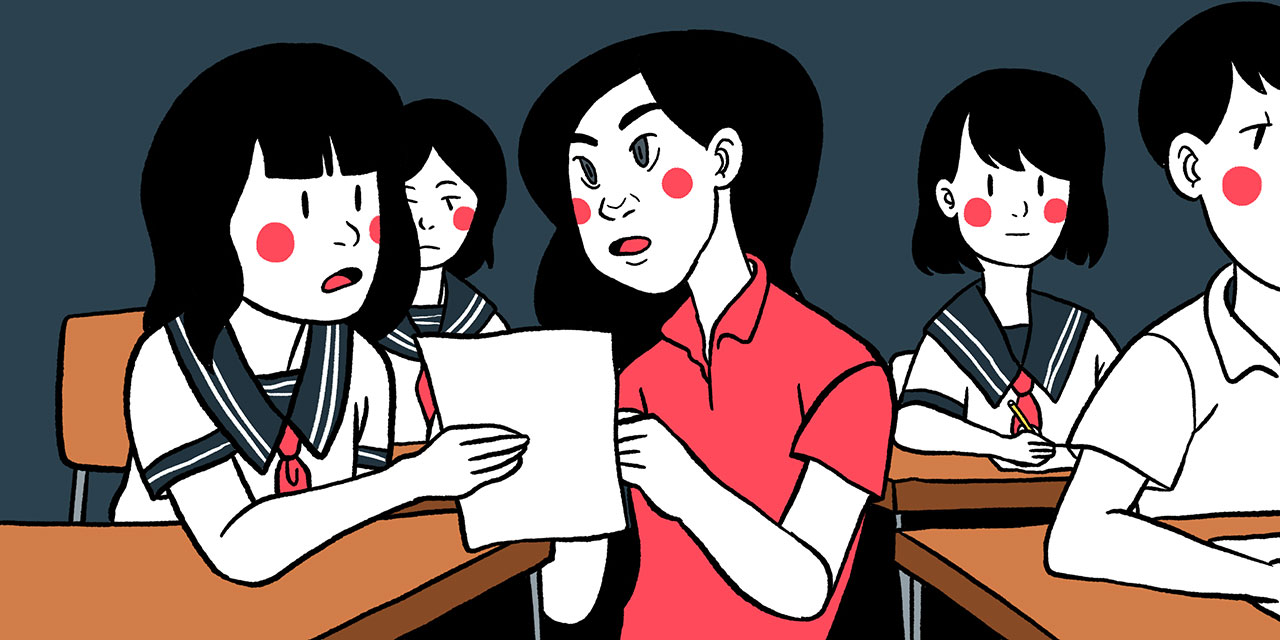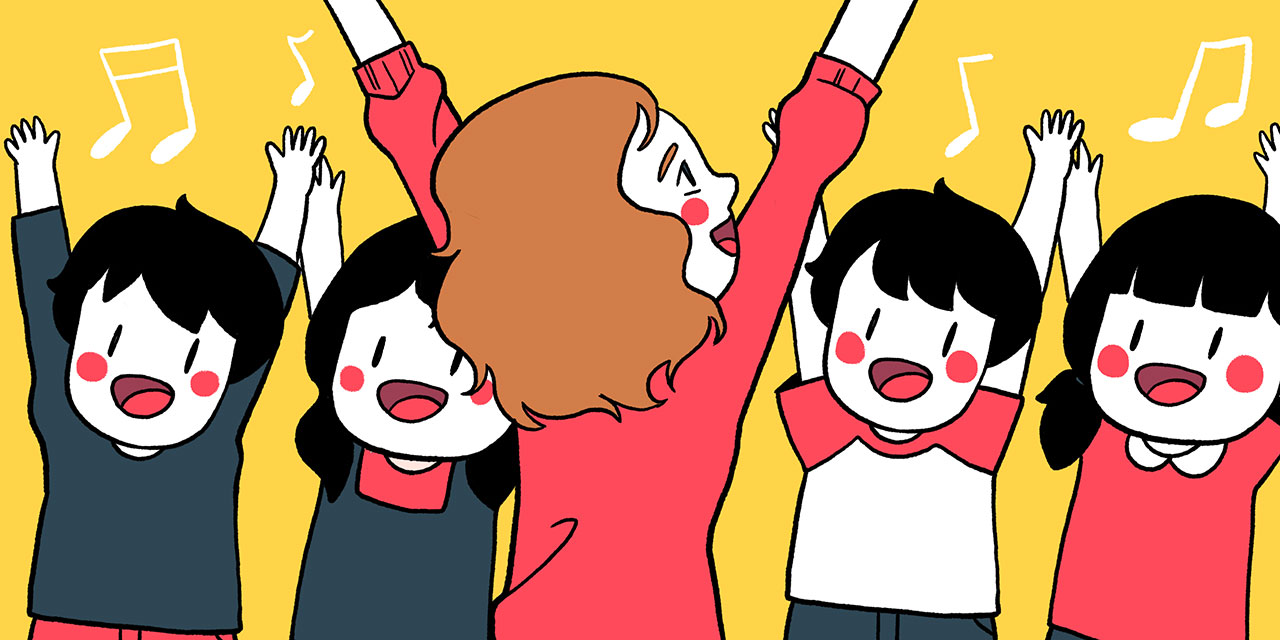As you consider applying to the JET Program, a lot of questions come to mind. Once you’re living in Japan on JET, there are even more questions.
In these situations, answers from JET alumni are invaluable. That's why I interviewed three former JETs, one from each type of Japanese school (elementary, junior high, and high school). Each taught five years on JET, the maximum allowed, and have recently returned. They have a wide range of experience, fresh recollection, and the perspective that comes with completing the program.
I asked each interviewee the same twenty-three questions. This way, you can gain insight on what JET teaching is like and ideas for handling tricky situations.
Let's start by learning about our interviewees.
Elementary School, Rebecca:

My name is Rebecca. I was born and raised in Portland, Oregon. I had been to Japan through my local sister city association in high school before I went on JET.
I was placed in rural Hokkaido and taught elementary school there for five years.
Junior High School, Matt:

I'm originally from Buffalo, New York and went to school in Toronto. I studied film and became interested in Japan after studying Japanese cinema. Since my career path was a little murky, I decided that I wanted to go abroad while I was still young. Best decision I ever made! I now work for an online education tech company in the US.
I was placed in Kochi City and lived there for five years teaching junior high on JET.
High School, Tori:

I'm thirty-three years old, born and raised in Vancouver, Washington. Currently, I'm teaching high school English to tenth, eleventh, and twelfth graders in the United States. My hobbies include snowboarding, soccer, ikebana, crochet, and drawing.
I was placed in Hirosaki, Aomori and stayed there five years teaching high school.
1. How did you feel when you initially found out about your school placement?
Elementary School, Rebecca:
I graduated with a degree in Elementary Education, so I was really excited to get to put some of what I had learned into practice. I also quickly found out that was the only place I got to plan and teach my own lessons.
Junior High School, Matt:
I couldn't wait to learn more about the schools and hear about the experiences from those already working at my BOE.
High School, Tori:
Stoked. I literally had zero expectations.
2. What was your first impression when you set foot at your school?
Elementary School, Rebecca:
I had five elementary schools. I remember being very surprised at how small the schools were. When I arrived there were three, five, seven, nine and nintey-nine students at my respective schools. At the school with three students, we had more adults than we did kids.
Junior High School, Matt:
I didn't expect it to be so large. I taught at a bunch of schools while on JET, but my first school was the biggest. I lived in a rural prefecture, so I expected the class sizes to be smaller.
High School, Tori:
It was so blistering hot I wanted to die. Aside from that, everyone was so friendly, curious, and just overall happy to have me.
3. Give us a rundown of the Japanese school where you taught. What makes it the best type of Japanese school?
Elementary School, Rebecca:
In the English classroom, I had more input or got to plan whole lessons, more than in junior high and high schools. Elementary school is more relaxed. The high school and junior high students are basically studying for exams to get into the next level of education. The elementary students are not.
Elementary students are also allowed to wear whatever they want, whereas the high school and junior high kids have to wear uniforms.
Junior High School, Matt:
I taught at many junior high schools over the course of my five years, and I had mixed experiences. My BOE tended to place me at tougher schools.
I was definitely surprised by the lack of discipline and how much control students had over things. That took a long time to get used to, but I figured out ways to make it work.
After some time, I began to look at teaching at junior high as a challenge. I figured out ways to connect with students, which made everything much easier. I also loved doing English Club and helping with speech contests in junior high. Whenever I got to interact with students one-on-one, it was a more productive, fulfilling experience for me.
High School, Tori:
The students in high school don't poke at you like elementary school kids. But they also aren't as adorable.
High school students really want to have genuine conversations with you. They're interested in knowing about where you come from and about your life. The conversations I had with my high schoolers were fairly deep, and some of them really wanted to learn to speak English.

4. How did you get to school each day?
Elementary School, Rebecca:
I used the BOE car to get to my distant schools and either my own car or my bicycle to get to the schools nearby. I'm not sure how common this is. I knew a few people who had access to a BOE car. I knew even fewer who had the BOE lend them a car to use all the time.
Junior High School, Matt:
It depended on the school. For most, I would take a bus. Occasionally I was able to ride my bike, but I mostly taught at schools that were a bit far from my apartment.
High School, Tori:
In non-snowy months I rode my bike twenty-five minutes uphill one way. In snowy weather I chose to walk to school, which was one hour each way. I owned a car, but the walk was lovely.
5. How many JTEs did you work with at a given time and what were they like?
Elementary School, Rebecca:
I had one JTE at each of my four small schools. At the "big" schools there was one each for fifth and sixth grade.
Junior High School, Matt:
Typically there were three if the school was an average size. All of my JTEs were very nice. Some were definitely better teachers than others, but all of the ones I worked with were incredibly kind.
High School, Tori:
I had three JTEs at my base school, four at the technical school, one at the agriculture school, and one at the school for the deaf.
6. What was the teachers' room like at your school?
Elementary School, Rebecca:
The teachers rooms were more relaxed than at junior high and high schools. I was usually seated at the couch when I came in. If I was there for more than one period then the schools usually assigned me a desk.
Junior High School, Matt:
Most were pretty much the same in layout. Everyone was organized by grade. Since I taught all the grades, I tended to sit next to school helpers, counselors, etc. It was generally pretty quiet in the teachers' room when students weren't around. I was surprised that so many students were allowed to come in and out of the teachers' room.
High School, Tori:
There were about thirty-five teachers in the main teachers' room. I had my own desk next to my supervisor, and it was always suuuuuuper quiet except during lunch time. During lunch, all the teachers around me were always laughing and talking.

7. How were your students?
Elementary School, Rebecca:
Most of my students were excited to learn and use English. I usually taught them some sort of question/answer combination so they could use what they had learned for communication. My students were excited to use what they were learning. They usually could reproduce what I was teaching them without accent, unless the JTE was speaking, too.
Junior High School, Matt:
It was a mixed bag. I had some wonderful kids and some that had some serious behavior problems. I taught in a very low income area of my city, so there were some rough schools around. It took some time for me to deal with that and figure out how to make things better. I wouldn't say my experience was normal for JET. Other JETs that taught outside the city tended to have better students. However, when you get kids one-on-one and try to talk to them on a personal level, you can definitely tell a difference. I think a lot of bad behavior was just for show, and they acted like that because they knew they could get away with it.
For me, the best way to make connections with students was outside of class. Staying after school playing basketball helped a ton as well as having conversations with kids before or after class. Talking about sports, music, or really anything that shows interest in their personal lives helped a ton. It was important that the kids saw me as a regular person and not just a teacher. It took me awhile to realize this, but once I did, things improved a great deal.
High School, Tori:
My students were well behaved, shy, kind, and afraid of making mistakes. It was hard to get them to speak aloud. This is very much the norm for academic schools. At the technical school, I found students to be much less inhibited and very self-confident. They didn't care when they messed up.
8. What were your students’ goals and focuses?
Elementary School, Rebecca:
The goal was generally to play with English and have fun.
Junior High School, Matt:
Unfortunately a lot of it was preparing for the standardized tests, which determined where you could go to high school. Kids tended to focus a lot on club activities, which sometimes felt more important than academics in junior high. They took their clubs very seriously, often coming in before school and staying late after.
High School, Tori:
Mainly speaking and gaining confidence in English.
9. What was an average work day for you, start to finish?
Elementary School, Rebecca:
I would show up at 9:30-ish. We would do second period with the kids, then I would head out to recess with them. After that, I had time until lunch (two periods) when I would prep for all of my lessons for the week.
I would spend lunch and recess with the kids and help clean up. After that there were two more periods. If the students were hanging around, I would play with them after school. If there were special things going on in the day like marathons or swimming lessons, I would usually join in.
Junior High School, Matt:
Each day would start with the morning meeting. After that, I would meet up with my JTE and discuss what we'd be doing for the day. I generally had about three to four classes a day. Between classes, I would generally be preparing for future lessons or doing my Japanese homework. During lunch, I sometimes ate in the teachers' room or with students in the classrooms.
After school, I would help clean and join club activities when I could. In general, I worked from around 8:00am to 5:00pm. Sometimes I would stay late for English Club or other activities.
High School, Tori:
Generally, I would go to work, teach, sit at my desk, sit at my desk more, teach, plan AJET stuff, and teach. I planned all my lessons in advance, and spent extra time planning for surprise lessons or changes to the schedule. After school in winter I would go night boarding. Every Wednesday I had ikebana club where I arranged flowers.

10. Describe an average class on an average day of JET teaching?
Elementary School, Rebecca:
We would start with greeting. A "Good morning, how are you?" type thing. Next we would review what the class had learned the week before and do some practice. Then we would add to that or teach a new topic, usually with flashcards and songs. Think "head, shoulders, knees, and toes" level songs. Next we would teach a question and answer, and play games using what they just learned. Finally everyone would do a final review to close out the class, asking the question to each other in pairs.
Junior High School, Matt:
At most of my junior high schools, the class size was between thirty and thirty-five kids. Each class was fifty minutes long.
High School, Tori:
I would start class with a warm-up game that teaches the students a concept and shows them how to use it. Then we would practice it together as a class. Finally, I would let them practice on their own in either pairs, groups, or through an activity I'd planned for that day.
11. What kind of tech was available at the schools where you taught?
Elementary School, Rebecca:
When I arrived, there was next to nothing tech-wise. When I left, most schools had smart boards and computers in the classroom. Smart boards are electronic whiteboards. They hook up to the computer with a USB and then, with a projector, turn your computer into a giant touch screen. If they're not calibrated correctly, they can be a pain. If they are calibrated correctly, there are a ton of fun things to do. Some of the activities in the textbook are more fun with the smart board.
Junior High School, Matt:
Not too much. They had computer labs, but doing any kind of tech presentation in class was a big to-do. They would have to bring in this special projector to view pictures, which there was usually only one of in the whole school.
That took a lot of organizing, so generally I just brought in flashcards and laminated them. I did a lot of one-shot teaching for certain classes, so it was tough to get into a rhythm with the teachers and spend time organizing lessons.
I would often bring my laptop in for English Club and show kids videos and pictures that way if I had a small group.
High School, Tori:
I basically had nothing. But we did end up with mini iPads during my last year of JET, which I utilized multiple times for pair learning.
12. What is it like to teach to students at elementary/junior/high school?
Elementary School, Rebecca:
The students knew less English, so more lessons needed gestures, visuals, and translation. But kids this age are way more excited about English and aren't studying for a test, so you have more freedom with your lesson topics.
Junior High School, Matt:
I think the toughest thing was getting kids interested. I lived in a rural prefecture, so most kids didn't see any use for learning English for their future. English class was more fun for them in elementary school when they would play games.
Junior high learning was much more structured around the textbook, which wasn't interesting to a lot of the kids. The trick was learning more about them on an individual level. Learning about what they're interested in made me much more appealing to the kids. They can tell when you're putting in that effort, which makes it more likely they'll put in effort in the classroom.
High School, Tori:
Teaching Japanese high schools students was awesome. Really, it was like teaching high school students in the US, just with a language barrier. The unique challenge is that the students care a lot about looking stupid or being wrong. They don't take a lot of risks in their speaking and writing.
13. What was the team teaching experience like for you? What role did you take in the classroom?
Elementary School, Rebecca:
I loved teaching, so I took the lead when they let me. In the lessons where we had to teach with Eigo Noto or Hi Friends, I was usually second in command, but my JTE was awesome and would let me make suggestions or change things as we went.
Japanese teaching style seems to be more formal/traditional than in the US. This usually means more lecture, more note taking, and less interactive classes. It wasn't true of all of my teachers, but it was true of a lot of them, especially the junior high and high school teachers.
In Western culture, we expect the speaker to be clear so the listener can understand. Japanese culture expects the listener to work out the meaning. This often means the teachers expecting students to come to them outside of class if they don't understand (some students do, many don't). It also results in very little differentiation. I haven't seen many teachers consider other ways of teaching. It's almost always lecture, (maybe an activity) and then a test. Projects are rare (maybe once a year) and are not as important.
Junior High School, Matt:
My experience was anywhere from being a human tape recorder to being actively involved in preparing for each lesson.
It seemed to me that teachers who had done more traveling and knew about other cultures were more likely to collaborate with me. Most of my JTEs spoke English very well, but their skills of executing a lesson varied greatly. The teachers who were laser-focused on teaching the plan without taking into consideration the personalities of the kids were most likely to fail. The ones who could relate to the kids had the most success. Those teachers also would go out of their way to create a unique plan for me when I was there, which was always appreciated. It was always great when they wanted me to communicate with students directly instead of having me just repeat sentences over and over again.
High School, Tori:
During my first year, my schools wanted to make me as comfortable as possible, and I often felt like a guest. But by the end of that year, I was teaching daily and doing all lesson plans for the team teaching classes. I have a degree in English Education, so they verbally told me they trusted me with lesson plans. Because of this I was essentially the lead teacher at all my schools. I planned all team-taught lessons, and assigned jobs for myself, the JTE, and the students during class time.

14. Did you face any adverse treatment as an ALT? If so, how did you handle it?
Elementary School, Rebecca:
Yes, but rarely at the Elementary school level.
Junior High School, Matt:
The biggest thing I had to learn was to be more proactive when things weren't going well. It was easy to blame the students, the teachers, or something else. But I had to learn to put more responsibility on myself to make things better. When I got frustrated with the lesson plans, I started making more suggestions to my JTEs, which definitely helped. When students misbehaved, I found out which clubs they belonged to and started spending more time with them outside the classroom.
Another important thing I had to remind myself was that I didn't know what was going on with kids in their home life. When kids would misbehave, it was easy to just say that they were bad seeds. However, there was often much more to their stories when I would talk to my teachers about them.
High School, Tori:
I communicated with teachers a lot. And I communicated often. When I first arrived I asked my supervisor if I could meet with each JTE individually and discuss expectations they had for me, I had for myself, and I had for them. It was really good and I was able to gauge quickly what was expected of me. I was also able to dispel any preconceived notions they may have had of me early on.
15. How much free time did your school allow? How often did you have to stay after school?
Elementary School, Rebecca:
This depended upon the school. With the vice principals who had more experience, they generally let me go sooner. The newer vice principals rarely sent me home early.
Junior High School, Matt:
Helping with English Club and speech contests were generally mandatory, but I always loved helping out with those. I was given a lot of freedom to get involved in various things. When I didn't have class, I could generally work on whatever I wanted to during my free time. It was never mandatory for me to stay late if there was no English Club. However, I often chose to stay a bit later to hang out with the kids.
High School, Tori:
I had so much free time when I wasn't teaching, which was about half the day every day. I only stayed after school when I chose to, like when helping students who wanted individual help. I stayed after for the school club I joined too.
16. Did you join any clubs?
Elementary School, Rebecca:
The elementary school only had clubs like once a month. If they had them on the day I was there, I was always welcome and encouraged to join.
Junior High School, Matt:
Yep! I joined the basketball club at most of my schools, which was always a terrific experience. I would also show my face at other clubs like the school band or tea ceremony at times. Making time to interact with the kids in that environment helped tremendously in the classroom. The kids got to know me better and started to respect me as a person. I loved working with the kids during English Club. I was able to make my own lessons and be around kids who genuinely wanted to learn English. Clubs were my favorite part of junior high by far.
High School, Tori:
Yes. Ikebana. I'm still doing it to this day!

17. What kinds of festivals did your schools hold?
Elementary School, Rebecca:
Sports days and school festivals were the most common. Many of the schools also had snow festivals.
Junior High School, Matt:
Sports Day and Culture Festival were always the two biggest events of the year. There were also smaller sports tournaments and music and art days throughout the year. I would always try to attend if I could. The students and teachers would always really appreciate when I took my personal time to attend those.
High School, Tori:
School festivals where students led everything.
18. What was the best part of your job?
Elementary School, Rebecca:
The students. I absolutely adored my elementary school students. I loved watching them grow in their love of English and in their abilities.
Junior High School, Matt:
I loved when I made real connections with kids on a personal level. It made the job so much more fulfilling. Also seeing kids remember what you taught them and watching their progress was terrific. When you're around to see when kids really get something, that's the best part about being a JET teacher.
High School, Tori:
I loved interacting with the staff at my school and enjoyed getting to know them on a personal level. I loved making jokes and working to help them understand the punchline. I also really enjoyed learning ikebana and sharing English with my very old sensei. I also loved learning Tsugaru-ben and impressing people with it.
19. What was the worst part of your job?
Elementary School, Rebecca:
Trying to convince JTEs that communication (not just translation) and developing a love of learning were important.
Junior High School, Matt:
Sometimes it was tough feeling like I wasn't respected or not part of the school. Occasionally my schools would forgot to tell me about a schedule change or new procedure. Not being consistently in the loop was hard.
High School, Tori:
Being misunderstood or having misunderstandings was difficult. I suppose all the free time could have been the worst part, but I made the most of my free time.
20. What was it like dealing with your city or prefectural BOE? What was your supervisor like?
Elementary School, Rebecca:
My supervisor was helpful in dealing with job issues, but she didn't really involve herself in classroom stuff.
Junior High School, Matt:
In general, I had a terrific relationship with them. They were always kind and eager to help. I had three supervisors in five years. They were all very different but were always supportive and easy to deal with. I felt lucky to be working with them!
High School, Tori:
It was awesome all around. Again, only because we communicated on everything. I think she and I both gave one another the benefit of the doubt whenever there was a misunderstanding. I tried my best to ask for feedback about my performance as a JET ALT every week. She eventually felt safe enough to do that once she knew I was serious.

21. Describe a time you navigated a communication issue or difficulty with your BOE and what did you do to resolve it?
Elementary School, Rebecca:
At the beginning I had so much trouble communicating because my supervisor spoke very little English and I spoke very little Japanese. I would often ask my JTEs to help me read the emails she sent me.
Junior High School, Matt:
One time I was about to go on vacation for three weeks. Right before, I heard I would need to stay in town longer because of a half day elementary school seminar. To me, this was unreasonable as I had already requested that time off. It could be tough to resolve these kind of situations because they'd insist on certain things being important when they often weren't. Often you'll get the "that's just the way it is" response. When I emphasized the importance of seeing my family and spending quality time with them, they understood and allowed me to take the time off.
High School, Tori:
Once I misunderstood the time when I was supposed to be at school, and ended up showing up late. I apologized profusely and reassured my supervisor I would never let it happen again.
22. What’s the most positive aspect of the Japanese way of doing school? Then give us the most negative.
Elementary School, Rebecca:
The most positive aspect is how much the teachers care about their students.
The most negative is how much the teachers move. They get invested in a community and then suddenly have a new placement, possibly hours away.
Junior High School, Matt:
It was always cool seeing what students could accomplish in groups. I loved the emphasis on collaboration and creating great stuff for the school. The group mentality has its negative points, but it was always awesome seeing kids work together on a common goal. I also loved the emphasis on the arts and music in schools.
I'd say the most negative is the focus on standardized testing and teaching from the textbooks. It hinders students from thinking critically and being more creative.
High School, Tori:
The most positive part of Japanese school is the work ethic. The most negative is the lack of confidence kids have.
23. If you could go back in time to your past self before you started your JET teaching career, what advice would you give?
Elementary School, Rebecca:
Don't let your lack of Japanese skills keep you from trying to meet with and communicate with people. If your lack of Japanese is too much for some people, move on. But there are a ton of people in town who will try with their limited English to talk to you.
Junior High School, Matt:
Be more proactive at the outset. Don't wait for things to get better, and start making them better yourself. Whenever possible, try to be around others and initiate more conversations. It's amazing when sometimes just saying "hello" to someone can make your and their day better.
High School, Tori:
Do everything exactly how you did.
I want to say a big thank you to Rebecca, Matt, and Tori for answering my questions about JET teaching and their experiences living in Japan. If you'd like to ask a JET alum about their experience teaching English abroad, check out US JETAA or JETAA International to get connected with former JETs in your area.
